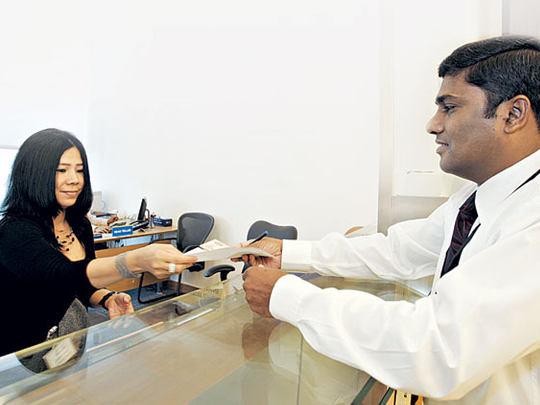
Dubai: The number of bank branches in the UAE and the number of bank staff declined in the second quarter of 2021 according to the latest Central Bank of UAE (CBUAE) statistics.
The second quarter Quarterly Economic Review of the CBUAE showed the number of licensed commercial banks in the country remained unchanged at 58 in the second quarter of 2021. The total of 58 banks comprises of 21 national banks and 37 foreign banks (including 10 wholesale banks).
Data showed the need for cost effectiveness and digitalization led to the closure of national branches, which decreased from 534 at the end of Q1 2021 to 522 at the end of Q2 2021.
Meanwhile, the number of banks’ staff fell by 414 (1.3 per cent quarter quarter) to reach 32,623 employees at the end of June 2021.
Total bank deposits increased on both yearly and quarterly basis. Gross credit increased on a quarterly basis, although it did not yet recover to pre-COVID-19 levels.
The CBUAE noted that overall, the financial soundness indicators remained healthy during this period, on the back of the gradual recovery of the economy.
Credit growth
The assets, credit and deposit growth in the UAE’s banking sector in the second quarter of 2022 points sustained recovery of the UAE economy according to the latest Central Bank of UAE statistics.
The Quarterly Economic Review of the CBUAE for the second quarter showed total assets of all UAE banks increased by 0.6 per cent year on year with the bank lending growth rebounding on a quarter on quarter basis for corporate retail, and SME sectors.
However, aggregate bank credit declined by 1.2 per cent year on year amid contraction on corporate loan portfolio compared to a year ago. Domestic credit decreased by 1.9 per cent driven mainly by reduction in lending to the government and the private sector.
In lending to domestic economy, the highest increase was in Mining and Quarrying by 33.4 per cent (Dh3.8 billion), followed by Electricity, Gas and Water by 8.3 per cent (Dh2.2 billion).
While total assets of national banks increased by 1.1 per cent year on year, total assets of foreign banks fell by 3.1 per cent. Foreign banks had a 12.5 per cent share in total assets and a 9.8 per cent share in gross credit.
Total assets of Islamic banks increased by 0.3 per cent while the share of conventional banks increased by 0.6 per cent. Analysis by type of banks shows that the share of assets at the end of June 2021 of Islamic banks was 18.7 per cent in total assets and 21.9 per cent in total gross financing of the banking system.
Overall, the CBUAE data shows, bank lending to Micro, Small and Medium Enterprises (MSMEs) increased by 2.1 billion to reach Dh94.6 billion at the end of the second quarter, 2.3 per cent higher year on year than the level at the end of Q2 2020.
Bank deposits
On the liability side, the overall bank deposits improved with the aggregate resident deposits (88.2% of total deposits) up by 1 per cent in the second quarter of 2021, owing mainly to an increase in government and private sector deposits.
Private sector deposits increased by 3.8 per cent year on year (Dh42 billion), while non-resident deposits (11.8 per cent of total deposits) increased by 12.6 per cent (Dh25 billion).
The improved deposits was reflected in a marginal decline in loans to deposits (LTD) ratio for the whole banking system which decreased to 92.7 per cent at the end of the second quarter, slightly below the 93.3 per cent at the end of the previous quarter.
About 77.6 per cent of deposits at the end of Q2 2021 are at conventional banks and the remaining 22.4 per cent at Islamic banks. Also, the share of national and foreign banks represented 88.3 per cent and 11.7 per cent, respectively.
Financial soundness
The financial soundness indicators of the CBUAE showed higher oil prices combined with the economic recovery is supporting the banking sector by improving the liquidity situation and credit demand for private sector credit, respectively.
In the second quarter, the CBUAE data shows, the advances to stable resources ratio (ASRR) of the banking system increased from 77.5 per cent at the end of March 2021 to 77.7 per cent at the end of June 2021, which indicates that the structural liquidity of the banking sector remained sound. Although eligible liquid assets, as a per cent of total liabilities fell to 18.3 per cent, it remained well above the 10 per cent minimum regulatory requirement, constituting an adequate buffer for the banking system.
Total liquid assets at banks at the end of the second quarter of 2021 stood at Dh476.2 billion, increasing by 10.1 per cent year on year (Dh43.8 billion higher compared to the end of June 2020).
Overall, the UAE banking system remained well-capitalised, with an average capital adequacy ratio (CAR) at 17.5 per cent, Tier 1 capital ratio at 16.3 per cent, and common equity tier 1 ratio (CET 1) at 14.5 per cent.








